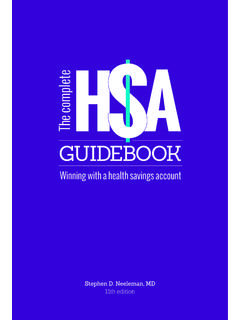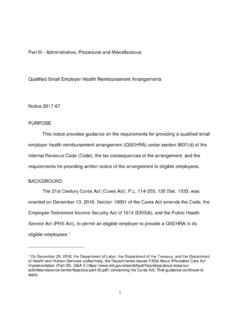Transcription of 125 Cafeteria Plans Notice 2013 -71 - Internal Revenue Service
1 1 Modification of Use-or-Lose Rule For Health Flexible Spending Arrangements (FSAs) and Clarification Regarding 2013-2014 Non-Calendar Year Salary Reduction Elections Under 125 Cafeteria Plans Notice 2013 -71 I. PURPOSE This Notice contains modifications to the rules for 125 Cafeteria Plans . First, sections II through V of the Notice modify the use-or-lose rule for health FSAs that is currently set forth in proposed regulations under 125 of the Internal Revenue Code (the Code). This modification permits 125 Cafeteria Plans to be amended to allow up to $500 of unused amounts remaining at the end of a plan year in a health FSA to be paid or reimbursed to plan participants for qualified medical expenses incurred during the following plan year, provided that the plan does not also incorporate the grace period rule.
2 This carryover of up to $500 does not affect the maximum amount of salary reduction contributions that the participant is permitted to make under 125(i) of the Code ($2,500 adjusted for inflation after 2012). This carryover option provides an alternative to the current grace period rule and administrative relief similar to that rule. Second, section VI of this Notice clarifies the scope of the transition relief provided in the preamble to proposed regulations under 4980H that allows greater flexibility for individuals to make changes in salary reduction elections for accident and health Plans provided through 125 Cafeteria Plans for non-calendar Cafeteria plan years beginning in 2013. II. BACKGROUND section 125(d)(1) defines a 125 Cafeteria plan as a written plan maintained by an employer under which all participants are employees, and all participants may choose among two or more benefits consisting of cash and qualified benefits.
3 section 125(f) defines a qualified benefit as any benefit which, with the application of 125(a), is not includable in the gross income of the employee by reason of an express provision of the Code (with certain exceptions). qualified benefits include employer-provided accident and health Plans excludable from gross income under 106 and 105(b), but exclude long term care insurance and certain qualified health Plans offered through an Exchange (also referred to as a Marketplace) established under 1311 of the Patient Protection and Affordable Care Act (the Act).1 Pursuant to 125(d)(2)(A), a 125 Cafeteria plan generally does not include any plan that provides for deferred compensation. Proposed regulations under 125 that predated the enactment of the Act generally have prohibited participants from using 1 Public Law 111-148 (124 Stat.)
4 1029 (2010)), amended by 10104 and 10203 of the Act. 2 contributions made for one plan year to purchase a benefit that will be provided in a subsequent plan year. Commonly referred to as the use-or-lose rule, this requires that unused benefits or contributions remaining as of the end of the plan year (that is, amounts credited to a health FSA participant s account that remain unused, referred to below as unused amounts ) be forfeited. See Prop. Treas. Reg. (c)(7)(C), (o), and (c). In 2005, the Treasury Department and the IRS modified the use-or-lose rule by adopting the grace period rule. Under the grace period rule, a 125 Cafeteria plan may permit an employee to use amounts remaining from the previous year (including amounts remaining in a health FSA) to pay expenses incurred for certain qualified benefits during the period of up to two months and 15 days immediately following the end of the plan year.
5 See Notice 2005-42, 2005-1 1204, and Prop. Treas. Reg. (e). This exception was based on other areas of tax law that do not treat certain arrangements as providing for deferred compensation if the compensation payment is made no later than the fifteenth day of the third month after the taxable year in which the services are performed. See, for example, Treas. Reg. (b)-1T, Q&A-2. section 125(i)2 provides that, beginning in 2013, a health FSA is not treated as a qualified benefit unless the 125 Cafeteria plan limits each employee s salary reduction contributions to the health FSA to no more than $2,500 per taxable year (as indexed for cost-of-living adjustments). Notice 2012-40, 2012-1 1046, provides that the term taxable year in 125(i) refers to the plan year of the 125 Cafeteria plan, so that the limit is applicable only beginning with the first day of the first plan year beginning in 2013.
6 Notice 2012-40 stated that [t]he $2,500 limit, while not addressing the use-or-lose rule, limits the potential for using health FSAs to defer compensation and the extent to which salary reduction amounts may accumulate over time. Given the $2,500 limit, the Treasury Department and the IRS are considering whether the use-or-lose rule for health FSAs should be modified to provide a different form of administrative relief (instead of, or in addition to, the current 2 month grace period rule). Notice 2012-40 requested comments on whether the proposed regulations under 125 should be modified to provide flexibility with respect to the operation of the use-or-lose rule for health FSAs in addition to the 2 -month grace period rule. Numerous comments were submitted in response to this request, the overwhelming majority favoring modification of the use-or-lose rule.
7 III. FURTHER MODIFICATION OF USE-OR-LOSE RULE The public comments argued for additional flexibility with respect to the operation of the use-or-lose rule for a number of reasons. These included the difficulty for 2 section 125(i) was added to the Code by 9005 of the Act, amended by 10902 of the Act, and further amended by 1403(b) of the Health Care and Education Reconciliation Act of 2010 (HCERA), Pub. L. No. 111-152. 3 employees of predicting their future needs for medical expenditures, the desirability of minimizing incentives for unnecessary spending at the end of a year or grace period, the possibility that lower- and moderate-paid employees are more reluctant than others to participate because of aversion to even modest forfeitures of their salary reduction contributions, and the opportunity to ease and potentially to simplify the administration of health FSAs.
8 In light of these comments, the Treasury Department and the IRS have determined that it is appropriate to modify the use-or-lose rule to permit the use of up to $500 of unused amounts in a health FSA in the immediately following plan year. Accordingly, an employer, at its option, is permitted to amend its 125 Cafeteria plan document to provide for the carryover to the immediately following plan year of up to $500 of any amount remaining unused as of the end of the plan year in a health FSA. The carryover of up to $500 may be used to pay or reimburse medical expenses under the health FSA incurred during the entire plan year to which it is carried over. For this purpose, the amount remaining unused as of the end of the plan year is the amount unused after medical expenses have been reimbursed at the end of the plan s run-out period3 for the plan year.
9 In addition to the unused amounts of up to $500 that a plan may permit an individual to carry over to the next year, the plan may permit the individual to also elect up to the maximum allowed salary reduction amount under 125(i). Thus, the carryover of up to $500 does not count against or otherwise affect the indexed $2,500 salary reduction limit applicable to each plan year. Although the maximum unused amount allowed to be carried over in any plan year is $500, the plan may specify a lower amount as the permissible maximum (and the plan sponsor has the option of not permitting any carryover at all). A plan adopting this carryover provision is not permitted to also provide a grace period with respect to health FSAs. Nor is the plan, for any plan year, permitted to allow an individual to salary reduce for qualified health FSA benefits more than the indexed $2,500 salary reduction limit or permitted to reimburse claims incurred during the plan year that exceed the applicable indexed $2,500 salary reduction limit (and any nonelective employer flex credits) plus the carryover amount of up to $500.
10 If an employer amends its plan to adopt a carryover, the same carryover limit must apply to all plan participants. A 125 Cafeteria plan is not permitted to allow unused amounts relating to a health FSA to be cashed out or converted to any other taxable or nontaxable benefit. Unused amounts relating to a health FSA may be used only to pay or reimburse certain 213(d) medical expenses (excluding health insurance, long-term care services 3 A run-out period is a period immediately following the end of a plan year during which a participant can submit a claim for reimbursement of expenses incurred for qualified benefits during the plan year. See Prop. Treas. Reg. (f). By contrast, a grace period is a period of up to two months and 15 days immediately following the end of a plan year during which a participant may use amounts remaining from the previous plan year (including amounts remaining in a health FSA) to pay expenses incurred for certain qualified benefits during that two-month-and-15-day period.)












